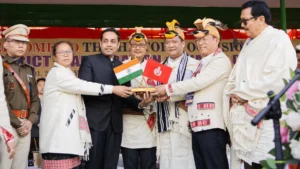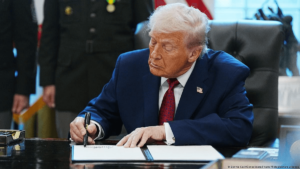The sudden and dramatic political upheaval in Bangladesh, with the ousting of Sheikh Hasina after 15 years as Prime Minister, has captured global attention. As the situation unfolds, India’s response has been notably restrained. This article explores the historical context of Bangladesh’s political evolution, India’s strategic interests in the region, and the implications of recent events for bilateral relations between India and Bangladesh.
Historical Background
The Partition and Independence
The borders of modern Bangladesh were established in 1947 when Bengal was divided between India and Pakistan during the Partition. This resulted in the creation of East Pakistan, which was part of the newly formed State of Pakistan. The struggle for independence gained momentum over the decades, culminating in the Bangladesh Liberation War of 1971.
Bangladesh Liberation War
On March 26, 1971, the Bangladesh Liberation War began, driven by the desire for independence from Pakistan. Under the leadership of Sheikh Mujibur Rahman, Bangladesh declared its independence. The Provisional Government, established in Mujibnagar on April 17, 1971, was pivotal in this struggle. The Provisional Government, led by Prime Minister Tajuddin Ahmad and military chief of staff M A G Osmani, declared “Equality, Human Dignity, and Social Justice” as its fundamental principles. The Indian military played a crucial role in the final stages of the war, intervening in December 1971 to ensure the surrender of Pakistani forces and support the creation of Bangladesh as an independent nation.
Sheikh Mujib and Early Independence (1972-1975)
Sheikh Mujibur Rahman, leader of the Awami League, became the 2nd Prime Minister of Bangladesh on January 12, 1972. His administration focused on secular Bengali nationalism and a socialist framework, drafting the liberal democratic constitution with socialist influences.
Internationally, Rahman secured key agreements such as the Indo-Bangladeshi Treaty of Friendship, Cooperation, and Peace with India. Bangladesh joined international organizations like the Organization of the Islamic Conference and the Commonwealth of Nations and gained support from countries like Japan and Egypt. However, his government faced internal challenges, including an insurgency by radical socialists and criticism from pro-business and conservative forces. A state of emergency was declared in 1974 to address mismanagement and corruption.
Military Coups and Presidential Regimes (1975-1981)
In August 1975, Sheikh Mujib was assassinated in a coup led by junior army rebels. Vice-President Khondaker Mostaq Ahmad took over but was overthrown by Brigadier General Khaled Mosharraf. After Mosharraf’s assassination, Lieutenant General Ziaur Rahman emerged as the leading figure, becoming President in 1977. Zia’s administration, under the Bangladesh Nationalist Party (BNP), restored free markets, promoted private sector development, and achieved economic growth.
Sattar and Ershad Administrations (1981-1990)
Following Zia’s assassination in 1981, Vice-President Abdus Sattar became President but was deposed by a coup in 1982. Lieutenant General Hussain Muhammad Ershad declared martial law and later became President in 1983. His regime focused on administrative reforms, privatization, and economic recovery but faced political repression and unrest. The Jatiya Party, Ershad’s political vehicle, won parliamentary elections in 1986 amid allegations of voting irregularities.
Return to Parliamentary Democracy (1990-2001)
Ershad resigned in 1990 under pressure from pro-democracy movements. The first caretaker government, led by Chief Justice Shahabuddin Ahmed, organized free elections in 1991, leading to the BNP’s victory and Khaleda Zia becoming Prime Minister. Zia’s government was marked by economic reforms but faced opposition boycotts and political turmoil. The second caretaker government, led by Chief Advisor Muhammad Habibur Rahman, held elections in 1996, resulting in Sheikh Hasina’s Awami League winning and restoring parliamentary democracy.
Hasina and Khaleda Rivalry (2001-2008)
Sheikh Hasina’s first term (1996-2001) was marked by notable achievements like the Ganges Water Sharing Treaty and Chittagong Hill Tracts Peace Accord. However, political violence and opposition boycotts persisted. The BNP, led by Khaleda Zia, won the 2001 elections amid allegations of vote-rigging and violence. Zia’s second term (2001-2006) saw improved economic growth but also faced corruption and increasing extremism.
Fourth Caretaker Government and Return of Awami League (2006-2009)
Political crises led to a fourth caretaker government in 2006, led by Fakhruddin Ahmed. This period saw an anti-corruption drive and stabilization efforts. The 2008 elections brought a landslide victory for the Awami League, led by Sheikh Hasina.
Hasina’s Second and Third Terms (2009-Present)
Sheikh Hasina’s second term saw significant achievements and challenges, including addressing extremist violence and managing the Rohingya refugee crisis. Her government faced criticism for alleged election rigging and political repression but also made strides in regional connectivity and economic growth. The 2018 elections solidified her party’s power amid controversy and opposition boycott.
Post-Independence Relations with India
From its inception, Bangladesh and India have shared a complex relationship marked by cooperation and contention. India’s role in Bangladesh’s independence cemented a foundation of mutual support, but the two countries have faced challenges in their relationship over the years. Issues such as border disputes, migration, and trade imbalances have influenced bilateral ties.
The Hasina Era: Strengthening Bilateral Relations
Rise to Power
Sheikh Hasina’s return to power in 2008 marked a new chapter in Bangladesh-India relations. Under her leadership, significant strides were made in strengthening ties between the two countries. The UPA government under Manmohan Singh and later the NDA government under Narendra Modi worked to enhance bilateral cooperation, focusing on national security, connectivity, and economic collaboration.
Key Achievements
- Land Boundary Agreement (LBA): One of the landmark agreements during Hasina’s tenure was the finalization of the Land Boundary Agreement in 2015, which resolved long-standing border disputes and improved bilateral relations.
- Transit and Trade Agreements: The signing of the transit accord facilitated the movement of goods through Bangladesh, enhancing connectivity between India’s northeastern states and the rest of the country. India also became Bangladesh’s largest export destination in Asia, with significant trade volumes.
- Diplomatic and Economic Cooperation: The G-20 summit invitation extended to Bangladesh in September of the previous year and Hasina’s visit to Delhi as the first foreign dignitary of Modi’s third term highlight the close diplomatic and economic ties between the two nations.
The Current Crisis: Impact and Implications
Sudden Fall of Sheikh Hasina
The abrupt removal of Sheikh Hasina has shocked both Bangladesh and India. The circumstances surrounding her departure—marked by violence and unrest—have raised concerns about the stability of the new political order in Dhaka. Reports indicate that Hasina’s removal was sudden and involved the military’s orchestration, following a deadly crackdown on protesters that led to over 100 deaths.
India’s Silent Response
India’s reaction to the crisis has been notably subdued. The Indian government’s silence can be attributed to several factors:
- Assessment of the Situation: India is carefully assessing the rapidly changing dynamics in Bangladesh. The primary concern is understanding the new political leadership’s stance towards India and ensuring that bilateral relations are not adversely affected.
- Parliamentary Procedures: The ongoing parliament session in India has also played a role in the delayed response. External Affairs Minister S. Jaishankar is expected to brief opposition parties and make a statement in the Lok Sabha before issuing a formal response.
- Strategic Interests: India’s reticence reflects its broader strategic interests in maintaining stability in Bangladesh. The country’s concerns include the impact of the crisis on regional security, especially given the insurgency issues in its northeastern states.
India’s Strategic Concerns
National Security
India’s northeastern states have long been affected by insurgency movements, many of which have historical links to Bangladesh. Ensuring stability in Bangladesh is crucial for India’s national security, as any political turmoil could potentially spill over into the northeastern region.
Connectivity and Infrastructure
India’s connectivity with its northeastern states is heavily reliant on infrastructure passing through Bangladesh. The country’s support for transit agreements and infrastructure projects is integral to facilitating trade and movement. Disruptions in Bangladesh could impact these vital connections.
Economic Interests
India’s economic interests in Bangladesh are significant. With trade relations expanding and investments growing, the stability of the Bangladeshi government is crucial for maintaining and advancing economic cooperation. The potential for increased trade deficits and economic uncertainties also poses a concern for India.
View from Dhaka
Bangladesh’s Perspective
In Dhaka, the removal of Hasina has elicited mixed reactions. While some view it as a victory for democratic processes and public sentiment, others are concerned about the potential for political instability. The movement that led to Hasina’s ousting is seen as a reflection of the popular discontent against her government’s policies and practices.
Implications for India-Bangladesh Relations
The immediate implications for India-Bangladesh relations include:
- Diplomatic Engagement: India must navigate its diplomatic engagement carefully to ensure that it does not alienate the new leadership in Dhaka. Building new relationships and maintaining open channels of communication will be crucial.
- Regional Stability: Both countries must work towards ensuring that the political transition in Bangladesh does not lead to regional instability. Collaborative efforts to address security and economic concerns will be important.
-
Public Perception: The perception of India in Bangladesh will be influenced by its response to the crisis. Balancing support for democratic processes with strategic interests will be essential for India’s diplomatic stance.




 Keyi Panyor to Become India’s First Bio-...
Keyi Panyor to Become India’s First Bio-...
 U.S. Withdraws from 66 International Org...
U.S. Withdraws from 66 International Org...
 UN Declares 2026 International Year for ...
UN Declares 2026 International Year for ...







